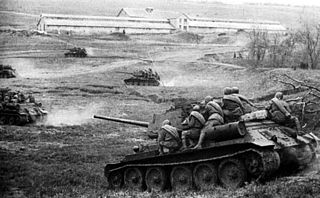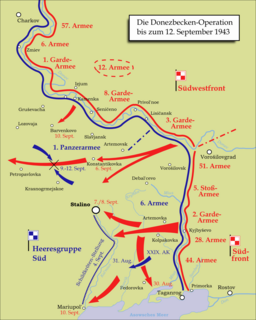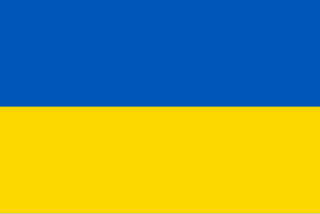 W
WThe Battle of Kursk was a Second World War engagement between German and Soviet forces on the Eastern Front near Kursk in the Soviet Union, during July and August 1943. The battle began with the launch of the German offensive Operation Citadel, on 5 July, which had the objective of pinching off the Kursk salient with attacks on the base of the salient from north and south simultaneously. After the German offensive stalled on the northern side of the salient, on 12 July the Soviets commenced their Kursk Strategic Offensive Operation with the launch of Operation Kutuzov against the rear of the German forces on the same side. On the southern side, the Soviets also launched powerful counterattacks the same day, one of which led to a large armoured clash, the Battle of Prokhorovka. On 3 August, the Soviets began the second phase of the Kursk Strategic Offensive Operation with the launch of Operation Polkovodets Rumyantsev against the German forces on the southern side of the salient.
 W
WThe Battle of the Dnieper was a military campaign that took place in 1943 in Ukraine on the Eastern Front of World War II. One of the largest operations of the war, it involved almost 4,000,000 troops at a time stretched on a 1,400 kilometres (870 mi) front. Over four months, the eastern bank of the Dnieper was recovered from German forces by five of the Red Army's fronts, which conducted several assault river crossings to establish several lodgements on the western bank. Kiev was later liberated in the Battle of Kiev.
 W
WBudy Ossowskie massacre was a mass murder of ethnic Poles carried out on 29–30 August 1943 by a death squad of the Ukrainian Insurgent Army aided by the Ukrainian peasants during the Massacres of Poles in Volhynia and Eastern Galicia. About 290 people were killed, including women and children, all of them, Polish inhabitants of the Budy Ossowskie village, located in the Kowel County of the Wołyń Voivodeship in the Second Polish Republic. Budy Ossowskie village does not exist anymore. It was burned to the ground by the OUN-UPA. The charred remnants of the village were cleared in Soviet Ukraine for grazing cattle. Overall, in the Kowel County some 7,300 ethnic Poles were murdered.
 W
WThe Dnieper–Carpathian offensive, also known in Soviet historical sources as the liberation of right-bank Ukraine , was a strategic offensive executed by the Soviet 1st, 2nd, 3rd, and 4th Ukrainian Fronts, along with the 2nd Belorussian Front, against the German Army Group South, Army Group A and elements of Army Group Center, and fought from late December 1943 to early May 1944. The battles on the right-bank Ukraine and in the Crimea were the most important event of the 1944 winter-spring campaign on the Eastern Front.
 W
WThe Donbas strategic offensive was a strategic operation of the Soviet Red Army on the Eastern Front of World War II with the goal of the liberation the Donetsk Basin, or Donbas.
 W
WThe Donbas strategic offensive was a military campaign fought in the Donets Basin from 17 July to 2 August, 1943, between the German and Soviet armed forces on the Eastern Front of World War II. The Germans contained the Soviet offensive in its northern portion after initial gains and pushed the southern portion back to its starting point.
 W
WGłęboczyca massacre was a mass murder of ethnic Poles carried out on 29 August 1943 by the troops of the Ukrainian Insurgent Army aided by the Ukrainian peasants. It exclusively targeted Polish inhabitants of the Głęboczyca colony, located in the Włodzimierz County of the Wołyń Voivodeship in the Second Polish Republic. About 250 Poles were killed, including 199 known by name including women and children. Głęboczyce does not exist anymore. It was swept from existence during the Massacres of Poles in Volhynia and Eastern Galicia, along with the neighbouring settlement of Ostrówek in powiat Luboml.
 W
WGurów massacre was a wartime massacre of the Polish population of Gurów, committed on 11 July 1943 by the Ukrainian Insurgent Army death squad from Group "Piwnicz" and Ukrainian peasants, during the Massacres of Poles in Volhynia and Eastern Galicia. The crime scene was the prewar village of Gurów located in Gmina Grzybowica, Powiat Włodzimierz in the Wołyń Voivodeship of the Second Polish Republic. Gurów village no longer exists.
 W
WHurby massacre was a mass murder of the Polish population of the Hurby village, perpetrated on June 2, 1943, by a death squad of the Ukrainian Insurgent Army (UPA) and so-called brushwood self defence commando made up of Ukrainian peasants, during the province-wide Massacres of Poles in Volhynia and Eastern Galicia in World War II. Hurby belonged to the Second Polish Republic before the war began. It used to be located in the powiat Zdobłunowski of the Wołyń Voivodeship. It is now a valley by the same name in western Ukraine. About 250 Poles were murdered in the attack, which was confirmed by the UPA commander for Volyn, Dmytro Klyachkivsky, who said in his communique of June 1943 that Hurby "went up in smoke".
 W
WJanowska concentration camp was a German Nazi concentration camp combining elements of labor, transit, and extermination camps. It was established in September 1941 on the outskirts of Lwów in Eastern Poland / Western Ukraine. The camp was named after the nearby street Janowska in Lwów of the interwar Second Polish Republic.
 W
WThe Third Battle of Kharkov was a series of battles on the Eastern Front of World War II, undertaken by the German Army Group South against the Red Army, around the city of Kharkov between 19 February and 15 March 1943. Known to the German side as the Donets Campaign, and in the Soviet Union as the Donbas and Kharkov operations, the German counterstrike led to the recapture of the cities of Kharkov and Belgorod.
 W
WThe Second Battle of Kiev was a part of a much wider Soviet offensive in Ukraine known as the Battle of the Dnieper involving three strategic operations by the Soviet Red Army and one operational counterattack by the Wehrmacht, which took place between 3 November and 22 December 1943.
 W
WKolky Republic was a temporary state composed of five regions of Volyn, measuring approximately 2500 square kilometers, created after being liberated from Nazi Germany in April 1943 by the Ukrainian Insurgent Army (UPA) and resistance fighters in Volyn. The state was named after its capital, the village of Kolky. The Ukrainians burned Roman Catholic church in Kolky killing about 40 Poles. The Kolky Republic lasted until November 4, 1943, when it was retaken by Nazi Germany using artillery and air attacks.
 W
WThe Koriukivka massacre was a mass murder of 6,700 residents of Koriukivka in Ukraine on 1–2 March 1943 by the SS forces of Nazi Germany. 1,290 houses in Koriukivka were burned down and only ten brick buildings and a church survived. The residents of neighboring localities were intimidated and refused to help the Koriukivka residents. On 9 March, the Germans returned to Koriukivka and burned alive some elderly people who had returned to the village after escaping thinking it was safe.
 W
WThe massacres of Poles in Volhynia and Eastern Galicia, were carried out in German-occupied Poland by the Ukrainian Insurgent Army, or the UPA, with the support of parts of the local Ukrainian population against the Polish minority in Volhynia, Eastern Galicia, parts of Polesia and Lublin region from 1943 to 1945. The peak of the massacres took place in July and August 1943. Most of the victims were women and children. Many of the Polish victims regardless of age or gender were tortured before being killed; some of the methods included rape, dismemberment or immolation, among others. The UPA's actions resulted in between 50,000 and 100,000 deaths.
 W
WThe Voronezh–Kharkov strategic offensive operation was a successful strategic offensive operation of the Red Army's Voronezh, Bryansk and South-Western fronts, carried out from January 13 to March 3, 1943 with the aim of defeating the German Army Group B and liberating a large territory and the important industrial and administrative centers Voronezh, Kursk, Belgorod and Kharkov.
 W
WMassacre of Wola Ostrowiecka was a 1943 mass murder of Polish inhabitants of the village of Wola Ostrowiecka located in the prewar gmina Huszcza in Luboml County of the Volhynian Voivodeship, within the Second Polish Republic. Wola Ostrowiecka no longer exists. It was burned to the ground during the Massacres of Poles in Volhynia and Eastern Galicia.
 W
WZagaje massacre was a mass murder of ethnic Poles carried out on 11–12 July 1943 by the troops of the Ukrainian Insurgent Army group "Piwnicz", aided by the Ukrainian peasants, during the Massacres of Poles in Volhynia and Eastern Galicia. Approximately 260–350 people were killed, including women and children. The village Zagaje was levelled out and does not exist anymore. It was located in the gmina Podberezie of the Horochów County in the Wołyń Voivodeship of the Second Polish Republic. Overall, in the Horochów County some 4,200 ethnic Poles were murdered, in nearly hundreds of separate locations before the end of the Polish-Ukrainian conflict. The village Zagaje is not to be confused with the Zagaje colony, located in gmina Czaruków, powiat Łuck, of the same voivodeship.